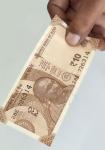The Union Jack fluttered atop Constitution Hall in Delhi on that winter day. Inside, the Constituent Assembly was in session. It was just past noon on December 19 in 1946 when Shrimati Dakshayani Velayudan started her address, 'Mr Chairman, before I express my views on the Resolution, let me pay my humble homage to our Revolutionary Father, Mahatma Gandhi. It is his mystic vision, his political idealism and his social passion that gave us the instruments to achieve our goal.'
Sixty years since that speech was made, similar invocations of Gandhi, Nehru and other well-known leaders continue across places of learning, on community grounds and in elite circles across India. People discuss their virtues and some debate their actions. These leaders have, after all, attained folklore status.
In this column, I bring attention to those other leaders who we have conveniently forgotten. They perish in historical exile. Unlike Bapu and Chacha Nehru, these leaders do not feature on the cover page of textbooks. One may not find their portraits at crossroads in towns and cities. Names such as Benegal Narsing Rau and Saiyad Mohammed Saadulla do not evoke emotion among most Indians, although their work is often a subject of study by constitutional scholars.
The leaders who I refer to played a significant role in the framing of the Indian Constitution. The 'making of the Indian Constitution' stands out as one of the most consequential events when comparing the success of India in its modern democratic form to most failed experiments around our neighbourhood or across the world.
The Indian Constitution, drafted by end of 1949, was an attempt by a nation to base its governance on laws and principles, a radical departure from a tradition of centuries when rajahs and plunderers forced their will on the masses.
For 60 years, these leaders have unintentionally been dwarfed by larger national personalities of their time. But, in a contemporary view, these leaders who drafted the Indian Constitution, stand as giants. Their role in converting an amorphous land in to a modern nation state is noteworthy, especially today, when we see other countries struggling to define and legitimise the transfer of power to a people. Most of these nations have not had an expansive, indigenous and participative process that creates a Constitutional framework, thus gaining their leaders legitimacy -- something that India benefited from 60 years ago.
The work on the framing of the Indian Constitution started well before independence. On December 9, 1946, when the first meeting of the Constituent Assembly was held, Dr Sachchidananda Sinha, the chairman of the Assembly, conveyed the gravity of the mission by saying, 'My prayer is that the Constitution that you are going to plan may similarly be reared for 'Immortality', if the work of man may justly aspire to such a title, and it may be a structure of adamantine strength, which will outlast and overcome all present and future destructive forces.' Thereafter, the Assembly let a core group of its members take the lead in the drafting of the Constitution.
Granville Austin in The Indian Constitution: Cornerstone Of A Nation identified 21 most important figures in the assembly (from hereon, referred to as the 'framers'). Of these, we are familiar with seven -- Dr Bhimrao Ambedkar, Acharya Kriplani, Pandit Nehru, Pandit Govind Ballabh Pant, Maulana Azad, Sardar Patel and Dr Rajendra Prasad. However, I surmise that but for the work of the 14 'forgotten framers' listed below, India's Constitution and its working would have fallen short.
M A Ayyangar: Represented Madras. Was a prominent member of the steering committee. Went on to become the speaker of the Lok Sabha.
Dewan Bahadur N Gopalswami Ayyangar: Represented Madras. Was a member of the rules, business, drafting and several other committees. Went on to become a minister in the government.
Dewan Bahadur Alladi Krishnaswami Ayyar: Represented Madras, was a member of the rules, drafting, union powers and several other committees.
Jairamdas Daulatram: Represented East Punjab. Was a member of the advisory, union subjects, and provincial constitution committees. Went on to become the governor of Assam.
Shankarrao Dattatraya Deo: Represented Bombay. Was a member of the minorities, and the fundamental rights sub-committees; besides, he actively participated in several other advisory committees.
Shrimati G Durgabai: Represented Madras. Was a member of the steering and rules committees.
T T Krishnamachari: Represented Madras. Was a member of the drafting committee. A businessman who went on to become a minister in the government.
H C Mookerjee: Represented Bengal. Was vice-president of the assembly and member of the minority rights sub-committee and provincial constitution committee. Went on to become governor of Bengal.
K M Munshi: Represented Bombay. Was one of the most prominent members of the Assembly. He was a member of several committees including the rules, steering and advisory committees. Went on to become a minister in the government and then the governor of UP.
Benegal Narsing Rau: Dr Rajendra Prasad, before signing the Constitution on November 26, 1949, thanked B N Rau for having 'worked honorarily all the time that he was here, assisting the assembly not only with his knowledge and erudition but also enabled the other members to perform their duties with thoroughness and intelligence by supplying them with the material on which they could work.' B N Rau was not a member of the assembly but was perhaps as important in the framing of the Constitution as Dr Ambedkar himself. Also represented India at the United Nations.
N Madhava Rau: Represented Orissa. Was a member of the drafting committee.
Saiyad Mohammed Saadulla: Represented Assam. Was a member of the steering and drafting committees.
Satyanarayan Sinha: Represented Bihar. Was a member of the steering committee and the provincial constitution committee. Went on to become the minister of parliamentary affairs.
B Pattabhi Sitaramayya: Represented Madras. Was a member of the rules, states, union subjects and provincial constitution committees. Went on to become the governor of MP.
The imprint of these 14 luminaries is seen across the Indian Constitution and especially in sections that deal with minority rights, federalism, the judiciary and fundamental rights. But, above all, these forgotten framers drove consensus among the assembly members such that the Constitution could be agreed upon in a timely manner, and the work of nation building could begin.
On the other side of the border, Pakistan took an inordinate amount of time to come up with its Constitution, approving it more than six years after India, on March 23, 1956, only to be undone by military rule on October 27, 1958.
Most of these [14] framers did not feature prominently in India's fight for independence, and that, Shri Kuladhar Chaliha, an assembly member from Assam, thought was an advantage since they 'could look into [the drafting of the constitution] dispassionately and produce the one that was necessary.' The framers were skilled and brought their diverse experiences in business, politics and administration to the task.
On November 18, 1949, when the Constitution was barely a week away from being completed, Shrimati Annie Mascarene, a Constituent Assembly member from Travancore state acknowledged the framers' 'erudite scholarship in political science and constitutional law' in her speech that was perhaps as eloquent as Nehru's given at the midnight hour.
So, as nationalistic fervour picks up this year during the nation's 60th anniversary; flags filled with rose petals are unfurled; and talk of India as a global power dominates the public stage, perhaps we could start including these forgotten framers in our discourse -- for they laid the structure Dr Sinha hoped would 'outlast and overcome all present and future destructive forces.'
On the occasion of the nation's 60th anniversary, the government, universities and private foundations should sponsor research that sheds more light on the life and achievements of these forgotten framers. Biographical work on the forgotten framers will help us understand our Republic better and will serve generations in ways one cannot foresee.
To instill a stronger belief in the Republic and its Constitution at a formative age, high school syllabus should be modified to include the work of these framers and of the Constituent Assembly. To ensure that our representatives are aware about the premise behind the Constitution, every new member of Parliament should have to go through a mandatory programme that covers the framers' deliberations. In a nation where symbolism goes hand-in-hand with patriotism, December 9 should be commemorated as Constituent Assembly day.
In 1996, President Shankar Dayal Sharma in his address on the 50th anniversary of the first session of the Constituent Assembly reminded the nation of 'the great stalwarts who have preceded us,' referring the Assembly members and the framers. Now, in 2007, as India celebrates its 60th anniversary, I urge President Pratibha Patil and Prime Minister Manmohan Singh to recognise the work of the forgotten framers of the Indian Constitution. Both, after all, are bastions of what Dr Sinha hoped would be a 'structure of adamantine strength.'
Although some of the 14 forgotten framers joined the government after the Constitution was completed, others quietly retired to private life -- but over the last six decades they have all gradually slipped in to oblivion. On this anniversary year, it is time we pay homage to the 14 forgotten framers -- for, in some ways, it is because of them that today the tiranga flutters atop Parliament House in Delhi.
Girish Rishi is a Chicago-based writer. He can be reached at girishrishi@hotmail.com







 © 2025
© 2025